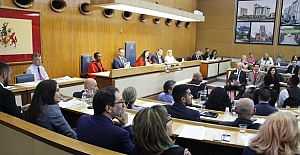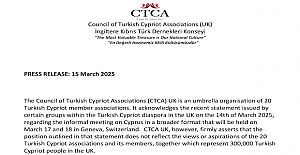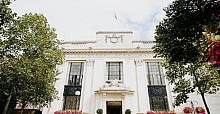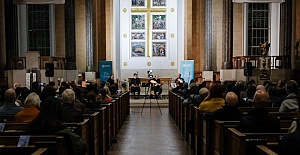In a judgement that has been 13 years in the making, on Monday 12th May 2014 the European Court of Human Rights ruled that Turkey must bear the cost of some 90 Million Euros in compensation payments to Greek Cypriots who have made claims for reparations due to the effects of the so-called ‘invasion’. Not only is this likely to have a damaging effect on the current talks for a settlement on the island, it also goes far further, for it also tacitly implies that the blame for the entire conflict lies solely upon Turkey. Whilst it is wholly unlikely that Turkey will abide by the ruling, nevertheless this also provides the Greek side with yet another powerful piece of propaganda material, that they are so skilled at employing. In fact, propaganda-spinning is about the only thing in which they (the Greeks) actually excel!
The Strasbourg based court said Greek Cypriots on Karpas had been severely restricted in their movement and access to education and "endured decades of not knowing [what would happen to them], which must have marked them profoundly." The Cypriot government didn't request damages for refugees who lost their homes and property. The judgment is final and can't be appealed. It is noteworthy that no mention was made, or ever is made, of the Turkish Cypriots who were displaced from Paphos en masse and who thereafter have acquired the collective of ‘Bafidi’s (out of Baf) for Baf is the Turkish name for that city. Similar upheavals of Turkish Cypriots were to take place on an island wide basis and of course, no fewer than 103 Turkish Cypriot villages were razed to the ground during the Orthodox Church-driven, wave of terror meted out by both Greek Cypriot and later by mainland Greek forces, from 1963 onwards.
For the purpose of enlightening the wider readership, and at this juncture, it must be remembered that this newspaper is read in many parts of the world now, let us remember that in November 1963 the Greek Cypriots had demanded the abolition of no less than eight of the basic articles that had been included in the 1960 agreement for the protection of the Turkish Cypriots. This was put into place by way of the notorious Akritas Plan which took its form in July 1963. The Turkish Cypriots, naturally, refused to agree.
The aim of the Greek Cypriots was to reduce the Turkish Cypriot people to the status of a mere minority; wholly subject to the control of the Greek Cypriots, pending ultimate destruction or expulsion of the Turkish Cypriots from the island. "When the Turkish Cypriots objected to the amendment of the Constitution, Makarios put his plan into effect, and the Greek Cypriot attack began in December 1963," wrote Lt. Gen. George Karayiannis of The Greek Cypriot militia ("Ethnikos Kiryx" 15.6.65) In fact, the first of the armed assaults on Turkish Cypriots began on December 21st 1963 there this is now remember as ‘Bloody Christmas’ by surviving Turkish Cypriots today.
Turkish Cypriots appealed to the guarantor powers for help, but only Turkey was willing to make any effective response. On July 20, 1974 Turkey intervened under Article IV of the Treaty of Guarantee. The Greek newspaper Eleftherotipia published an interview with Nicos Sampson on Feb. 26, 1981 in which he said, "Had Turkey not intervened I would not only have proclaimed ENOSIS, I would have annihilated the Turks in Cyprus." Furthermore, Arch Bishop Makarios, the founding President of the Republic of Cyprus, declared at the point of the Turkish Intervention in July 1974, that “If they [Turkey] come to save the Turkish Cypriots, they will find none left to save”]. A Godly man he was-Not!
Previous to the July ’74 intervention, there had been an earlier such operation by way of the Battle of Tylliria. The bitter fighting between Greek and Turkish Cypriots that collapsed the constitutional structure of Cyprus and drove hundreds, if not thousands, of Turkish Cypriots into protected enclaves paused in August 1964. The ensuing period was a battleground of public relations, of managing an embargo on the enclaves, and of international wrangling. It is a particularly crucial period in the Turkish Cypriot narrative, because Turkish Cypriots claim that the division of the island was engineered in 1964 (not with the intervention by Turkish troops ten years later) by Greek Cypriots, including President Makarios. By all accounts, conditions in the enclaves were very poor, and Turkish Cypriots who left the enclaves were frequently subject to harassment and worse. The conclusion of the Battle of Tylliria in August 1964 was to lead to a most uneasy truce between the two sides until this too broke down in November 1967.
On 6 August, National Guard and Greek army units attacked Turkish Cypriot villages around Kokkina. Turkish Cypriot civilians and fighters were forced to retreat into a narrow beachhead and were subjected to an intense artillery bombardment. On 7 August, Turkish aircraft had over flown the battle zone and fired their weapons out to sea as a show of strength to reinforce a Turkish ultimatum to stop the attack. On 8 August, Turkish jets attacked National Guard and Greek troops in the Tylliria region. UNFICYP was unable to negotiate a ceasefire. President Makarios announced that if Turkish air attacks were again carried out, he would order an attack on every Turkish Cypriot village and quarter in Cyprus. Despite this threat, it is probable that Turkey would have continued its air attacks, or would even have launched a full-scale military intervention, if the Cyprus government had not heeded the Security Council's resolution for a ceasefire on 9 August. A ceasefire came into effect by 10 August and UNFICYP established observation posts around Kokkina and Limnitis.
The Greek side did not learn the lesson of the Tylliria battle, that a military solution to enosis must be eschewed, but rather that Greek and Greek Cypriot forces must be better prepared for an inevitable future confrontation with the Turks. By late 1967 however, Turkey was amassing her forces in south-west Anatolia in preparation for what would, in July 1974, become the Attila 1 & 2 offensives.
The “Cyprus Problem”, the long conflicts, loss of life, displacements and property and land losses are entirely attributable to none other than the Orthodox Church who, from as far back as 1879 declared their enosis goals. If any party should be paying compensation it is they who should be doing so, and to both Turkish Cypriots as well as their Greek Cypriot flock


 Prime Minister Keir Starmer's 2025 Easter message
Prime Minister Keir Starmer's 2025 Easter message After Nesil Caliskan a by-election will be held in Jubilee ward in Enfield
After Nesil Caliskan a by-election will be held in Jubilee ward in Enfield Publishing the analysis, Labour’s Cllr Ergin Erbil said Everybody in Enfield deserves basic rights
Publishing the analysis, Labour’s Cllr Ergin Erbil said Everybody in Enfield deserves basic rights Gaza-Israel conflict Statement from Cllr Ergin Erbil, Leader of Enfield Council
Gaza-Israel conflict Statement from Cllr Ergin Erbil, Leader of Enfield Council The European Union called on Turkey to uphold democratic values
The European Union called on Turkey to uphold democratic values Turkish citizens in London said Rights, Law, Justice
Turkish citizens in London said Rights, Law, Justice The Council of Turkish Cypriot Associations Geneva response letter
The Council of Turkish Cypriot Associations Geneva response letter Sustainable Development and ESG, Will This Become the Course for Turkic World
Sustainable Development and ESG, Will This Become the Course for Turkic World The 'Prince of Paris' has impressed in his first EuroLeague season
The 'Prince of Paris' has impressed in his first EuroLeague season Saran Media And Euroleague Basketball Extend Media Rights Partnership for Four More Years
Saran Media And Euroleague Basketball Extend Media Rights Partnership for Four More Years Will Rangers be Jose Mourinho’s next victim?
Will Rangers be Jose Mourinho’s next victim? Jose Mourinho's Fenerbahce face Rangers on Thursday
Jose Mourinho's Fenerbahce face Rangers on Thursday Barclays has become the biggest UK lender so far to cut mortgage rates
Barclays has become the biggest UK lender so far to cut mortgage rates THE SPRING STATEMENT EXPLAINED, UK ECONOMIC OUTLOOK AND GROWTH FORECASTS
THE SPRING STATEMENT EXPLAINED, UK ECONOMIC OUTLOOK AND GROWTH FORECASTS Launch of Made in Enfield gift shop to celebrate local artists and designers
Launch of Made in Enfield gift shop to celebrate local artists and designers Trial used smart Wi-Fi sensors for live building occupancy data to optimise
Trial used smart Wi-Fi sensors for live building occupancy data to optimise

















